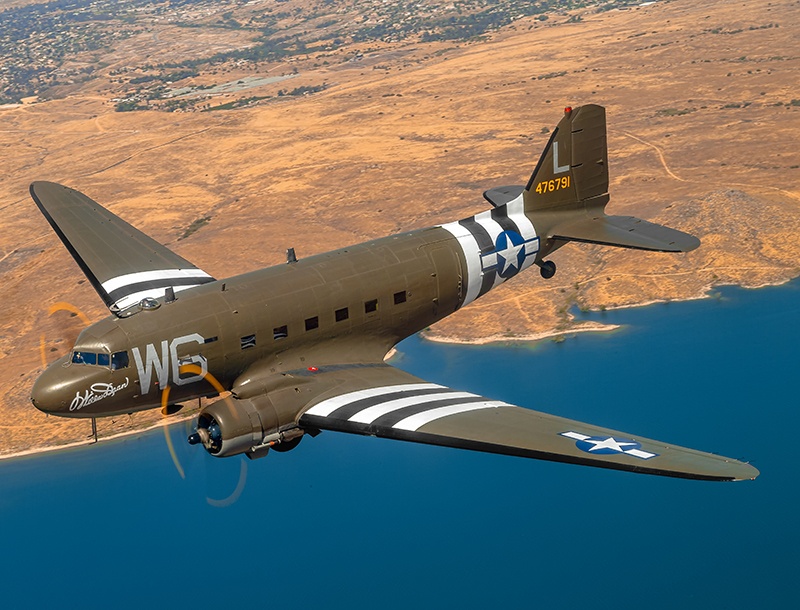The Douglas C-47 Skytrain, also known as the Dakota in British and Commonwealth service, is one of the most iconic and versatile aircraft of World War II. Developed from the civilian Douglas DC-3, the C-47 played a pivotal role in military operations, serving in a wide range of roles from troop transport to medical evacuation. Its durability, reliability, and adaptability made it a cornerstone of Allied air logistics.
Development and Design
The C-47 Skytrain was a military adaptation of the Douglas DC-3, an aircraft that had already established a reputation for reliability and efficiency in commercial aviation. The DC-3’s robust design and proven performance made it an ideal candidate for military service. The C-47 variant featured several modifications to meet military needs, including a reinforced floor, a large cargo door, and provisions for paratrooper seating.
The prototype C-47 made its first flight on December 23, 1941. The aircraft had a wingspan of 95 feet (29 meters) and a length of 64 feet 5 inches (19.6 meters). It was powered by two Pratt & Whitney R-1830-92 Twin Wasp radial engines, each producing 1,200 horsepower. These engines gave the C-47 a cruising speed of about 160 mph (257 km/h) and a range of 1,500 miles (2,400 kilometers), with a service ceiling of 24,450 feet (7,450 meters).
Performance and Capabilities
The C-47’s performance and capabilities were key to its success. It could carry up to 28 fully equipped troops, 6,000 pounds (2,722 kilograms) of cargo, or a combination of the two. The aircraft’s large cargo door facilitated the loading and unloading of equipment and supplies, making it highly effective for logistics operations. The reinforced floor allowed it to carry heavy loads, including jeeps and light artillery.
One of the most notable features of the C-47 was its versatility. It could be adapted for various roles, including:
- Troop Transport: Moving soldiers to and from battlefronts.
- Cargo Transport: Delivering vital supplies and equipment.
- Medical Evacuation: Transporting wounded personnel to medical facilities.
- Paratrooper Drops: Deploying paratroopers behind enemy lines.
- Glider Towing: Towing military gliders for airborne operations.
Operational History
The C-47 Skytrain saw extensive service during World War II and was instrumental in several key operations. One of its most famous roles was during the D-Day invasion on June 6, 1944. The C-47s were used to drop paratroopers from the 82nd and 101st Airborne Divisions into Normandy, playing a crucial role in the success of the invasion. These aircraft also towed Waco CG-4 gliders carrying additional troops and equipment.
In the Pacific Theater, the C-47 was vital for island-hopping campaigns, transporting troops and supplies across vast distances and often to remote and rugged airstrips. Its ability to operate from short, improvised runways made it invaluable in these operations.
The C-47 continued to serve after World War II, seeing action in the Berlin Airlift (1948-1949), where it helped deliver essential supplies to West Berlin during the Soviet blockade. It also played roles in the Korean War and the early stages of the Vietnam War.
Legacy and Impact
The Douglas C-47 Skytrain’s legacy is one of versatility and reliability. Its contributions to the Allied war effort were immense, providing a critical logistics capability that supported numerous operations and helped ensure their success. The aircraft’s ability to operate in diverse environments and perform multiple roles made it a favorite among crews and commanders alike.
Many C-47s remained in service long after World War II, with some being converted for civilian use as the DC-3. The aircraft’s durability and ease of maintenance contributed to its longevity, and it continued to be used by various air forces and civilian operators around the world.
Today, the C-47 is celebrated in aviation museums and at airshows, where restored examples continue to fly. These aircraft serve as a testament to the ingenuity of their design and the crucial role they played in 20th-century military aviation history.
Conclusion
The Douglas C-47 Skytrain stands as a symbol of adaptability and endurance in military aviation. Its development from the Douglas DC-3 resulted in an aircraft that could fulfill a multitude of roles, making it indispensable to the Allied war effort. The C-47’s operational history is marked by significant contributions to major World War II campaigns, as well as continued service in subsequent conflicts. Its enduring legacy is a tribute to its design and the pivotal role it played in shaping the course of history.



